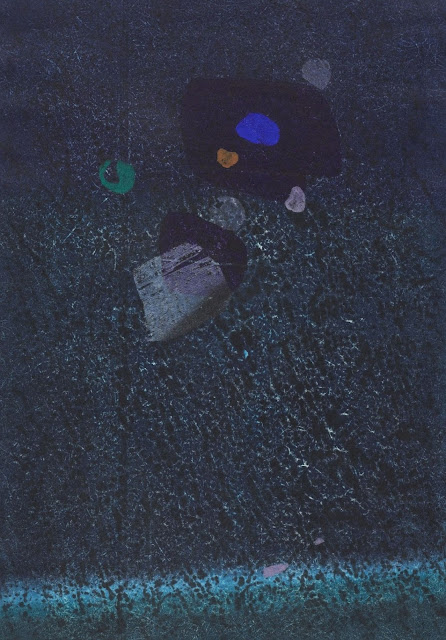"Hideo Hagiwara is a master of the Japanese contemporary woodblock printing technique and one of the best known Japanese artists of the 20th century. He employs a broad variety of printmaking techniques including woodblock, lithograph, etching and stencil. Born in Kofu City, Yamanishi Prefecture in 1913, Hideo Hagiwara lived in Korea and Manchuria during his early years. After returning to Japan in 1929 he studied oil painting at the Tokyo School of Fine Arts from which he graduated in 1938. While in school he briefly studied woodblock printing with Hiratsuka Un'ichi (1895-1997), a major figure in the sosaku hanga (creative print) movement. He spent the first 20 years of his career as a painter (and continued to paint throughout his career), but during his recuperation from tuberculosis (1953-1955) he took up woodblock printing. In 1958 he began to explore abstraction and began employing innovative and experimental printmaking techniques. His work began to receive international acclaim in the 1960s with numerous international exhibitions. Hagiwara served as Chairman of the Japanese Print Association for many years and in 1989 he was awarded a gold medal by the Nobel Prize Committee for five works produced on themes from the novels of Kawabata Yasunari. He passed away on November 4, 2007 at the age of 94.To visit Hagiwara is to become aware of some of the sources that stir his inspiration. Art objects and artifacts of man's long history are carefully chosen to embellish the living and working spaces. These objects span much time and geography with a common quality of genuineness, directness, perhaps humbleness - a sort of primitive, of-the-earth sophistication with meaning for all time.Among his interests are the pots created more than 4,000 years ago during Japan's Jomon Period. These pots represent Japan's earliest artistic achievements. They belie their ancient origin in the fresh treatment of the clay. There are scratchings, impressions from ropes, and thin rolls and globs of clay pressed onto the clay body, similar to contemporary techniques that feature the natural characteristics of clay.One can appreciate Hagiwara's interest in such examples, where clay, hand, and tool work in natural harmony. His own work reveals a similar harmony of wood, hand, and tool. The influence on Hagiwara's work from Jomon pots and other artistic achievements of man's past has been strong, but indirect. Hagiwara tells us he does not borrow style or imagery. Rather, he absorbs the atmosphere of these creations, appreciating their directness, their natural use of material and tool, integrity of form, and use of scale and space ."(myjapanesehanga.com)

Painting is like silent poem, said Simonides, poet from ancient Greece.Paintings are icons, doors to the Platonian world above the heavens. Paintings on my blog are just those icons, which lead a viewer into the magic world of harmony and beauty. Artists who present their achievements on my blog have a very different cultural and national background, they represent variety of artistic traditions and schools
Subscribe to:
Post Comments (Atom)













No comments:
Post a Comment